Empire of Signs - Roland Barthes - “...to descend into the untranslatable, to experience its shock without ever muffling it”
- In Japanese there is a divide between animate and inanimate ... "the very structure of Japanese restores or confines there beings to their quality as product...cut off from...the living thing.”
- There is a sanctuary in the wall of “murmuring” of an unknown language.
- The body is of great importance (gestures, clothing, expression included) for it is the body that has “its own narrative, its own text.”
- Since Japanese food is usually raw - merely cut up - you are the one who composes what you eat by selecting when and how you put something in your mouth.
- “ Japanese food appears to be: a written food, tributary to the gestures of division and selcetion which inscribe the foodstuff, not on the meal tray..., but in a profound space which hierachizes man, table, and universe. For writing is precisely that act which unites in the same labor what could not be apprehended together in the mere flat space of representation.”
- Cut up food and chopsticks relationship - one because of the other and the other because of the other. A lot of control - to choose and carry - in chopsticks.
- Sukiyaki - kind of a metaphor for conversation?
- Tempura is ironic - oily and fried - but still light and lacy - freshness is based on oil freshness
- “It is you who eat, but it is he who has played, who has written, who has produced.”
Okay! So I have to admit that that was pretty confusing - though it was a pleasure to read. I tend to like this kind of writing - flowery I guess you could call it - but I’m not quite there in being able to understand such literature... What sensei was saying in class was basically that Barthes was taking elements of Japanese culture that he observed and writing/creating his own fictitious world based on his observations in the foreign country. Like a lot of pieces we’ve read, rawness was a huge part, along with ideas of chopsticks, delicacy, instruments, and presentation not just of food but of bodies as well. Interesting! Ideas that stuck out at me and quotes that I feel are important I noted above!
Mercury in Japan’s Whale MeatJohn Tibbetts- In Japan cetaceans are eaten (whale and dolphin) but recently there have “dangerously high levels of mercury” found in the meats.
- The ones that are higher up on the food chain (toothed whales) consume and retain more pollutants in the body.
- The rising issue is that baleen whale - which is safer - is getting mixed up dolphin - which isn’t.
- This includes samples of dolphin with levels as high a 2.51 ppm when it is supposed to 0.4ppm.
- Killer whales with average total of 46.9 ppm
- For the boiled organs of small cetaceans, heavy metal and mercury contact was an average of 370.00 ppm.
- One meal of whale internal organs can end in death...
- 2002 Japan updated the law demanding all seafoods are to be labelled with a specific name (though there is no penalty for mislabeling).
- In 2003 they limited pregnant women’s consumption to 60-80 grams for one week, and only once every two months.
- Since cetacean consumption is less popular, it is not as much of a concern for the general public...“Yet” says John Tibbetts
South Park Episode "Whale Whores" At the American style Six Flags Discovery Kingdom, there are different dolphin and whale presentations going on but a stampede of Japanese come and stab the dolphins and whales to death screaming “Fuck you”. Because they “don’t really like dolphins very much, at least not as much as normal people do.” The whole country is represented to share this opinion. Environmentalists are cast as “tree huggers” and then the people who working to stop the Japanese are “not protestors” but “pirates” in the show “Whale Wars”. But when confronted with action, they don’t know how to do anything (just talk...and throw stinky butter...afraid of doing anything illegal). Japanese are cast as barbaric, while everyone is discussing how to fool the public in thinking they are “hardcore” the Japanese harpoon the captain. Stan makes actually does something and their ship blows up - “things actually happen now” is written on magazine covers and the shows popularity skyrockets. Whale Wars show cast is interviewed on Larry King show - though Stan does it to help whales/dolphins, everyone else is convinced it is only for the ratings (thus they resort to violence- which is loved). Cartmen and Kenny join the movement when the TV show became famous (though they called Stan a “tree hugger” before. - Deadliest Catch ship also becomes an enemy (taking views away from their show)
- Whales come to help Stan by taking away the Deadliest Catch crew...(appreciation of their dedication, display of their intelligence)
- Kamikaze come take out the whales that just saved Stan.
- Only the boys survive and are held in Japanese jail after which they find out that the Japanese are angry about Hiroshima because the ones who dropped that bomb and scarred the nation were a dolphin and whale (seen from a photo given to the Japanese from the Americans).
- The boys/America admit that the photo had been altered but the “real” photo is of chicken and cows...“now they are normal like us.”
THE COVE directed by Louie Psihoyos and written by Mark Monroe
This documentary shook me from the inside out. It is something I knew nothing about going into it and came away very upset... Ric O'Barry was the main man of the film - back in the 1960s he was trainer for the dolphins the TV show Flipper. He kept saying things along the lines of how he had built up this industry of dolphin training in about ten years and he had spent the past thirty some years trying to take it down - now that is had become a multi-billion dollar industry. What triggered him was when one of his beloved dolphins died in his arms - for she chose not to go up for breath - essentially committing suicide.
In Taiji they bring in dolphins using a wall of sound and trap them in a cove so that people from aquariums can pick and choose for dolphin supply -worldwide. The rest are slaughtered around the side of the cove where no one is allowed to go and definitely not photograph (shown below, the blood of the dolphins in the water). O'Barry and Louie managed by setting cameras in fake rocks and planting them in the cove at night - literally risking their lives to capture this footage.
23,000 dolphins are killed a year. The weird thing is, not many people eat dolphin meat and no one knows about the cove. Not to mention the dolphin meat is highly toxic due to the workings of the food chain as we now know from Tibbett's article.
The Japanese government convinces the fisherman of Taiji that it is not only their long standing tradition but also pest control so that the Japanese people can eat more fish that these "pests" do not.
Taiji the town hides this horror through whale/dolphin sculptures, museums (that sell the meat as souvenirs), parks and even boat rides in the shape of a whale.
You just have to watch it.
However I do want to say something similar to what is executed in the South Park episode. I do not believe it is fair to call the Japanese alone horrendous and write them out to be the most cruel in the world because they insist on keeping whaling because we do similar horrors against the animals that we consume. I believe that in reality we are past the point of being able to make decisions that are truly "right". There are too many mouths to feed in the world - and that is where the problem originates. Hoorah for ending on a happy note...
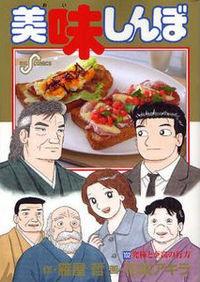 Oishinbo’s Adventure’s in Eating Lauri Brau- Food in Japanese media is very prevalent; food travelogues, celebrity cooking shows, films and, manga - Oishinbo specifically is gourmet food manga.
- 1970s - food had infested itself into the manga world (apprentices/athletes journeys became popular)
- These manga are often targeted towards men (men rule the professional realm of food)
- Shows readers the the array of cuisines (from other country’s to experimenting in the home)
Cuisine as Comic Book- Japanese language’s onomatopoeia allows cooking manga to have full power (texture, tempurature, sound)
- Graphic realism
Oishinbo: An “Ultimate Menu” of Information and Entertainment
- “cultural treasure to bequeath the future” (carefully selected chefs for this assignment)
- food to the rescue
- Oishinbo acts as a “guide” in Japan for people who do not know how to make their way through so many of the cuisines available in Japan
- also focuses on Japanese “traditional” ways (how to steam rice, make miso soup etc)
The Contest and the Way of Cuisine- find what is right (zen in making sushi vs. arrogance and haste)
- “motenashi no kokoro” (is THE “way”)
- “the only thing thing that can move a person’s spirit is another person’s spirit...Cooking is an act of communication between souls.”
- creating food the suits the consumer - does not have to be gourmet to be good
- competitions to settle conflict - lessons taught
Rice and the Expression of Japanese Identity- rice is a “sacred symbol”
- subject of rice episodes are many (Thai rice, other rice importation issues, Japanese Mystification)
- Samurai used to be paid in rice (edo)
- fall festival circulate around rice harvest and “the soul of the Japanese”
Food and Memory- changes in the food industry (not as good as I remember...)
- episode on a man’s quest for “mother’s love”
- food in place of words for communication is common in Oishinbo
- no time for breakfast = impoverished Japanese society
- “What they say is certainly true: you can clearly see the condition of a society through its food”
- many sentimental stories = cultural identity
Oishinbo (the manga)Story by Tetsu KariyaIllustrations by Akira Hanasaki
The manga starts out with intro of high lighted dishes and how to prepare them “properly” according to Japanese tradition and culture (which means that any food has to appeal to all five senses). The first chapter basically introduced us to Yamaoka and Kaibara (son and father). After reading the Oishinbo article I was expecting a manga that had to do with food - but not anything on this level! This could be more of an illustrated cookbook to some extent. When Yamaoka dips the konbu into the water to make dashi, three panels were used to show the exact steps. Not just that, though. They also explain all the reasons for why something is good or bad so you are learning a lot from it - it seems like a lot more than a manga. I feel the gender roles are pretty prevalent. The otaku is a woman who takes the lashes from Kaibara and does things like apologize for showing emotions. Then Kurita, though she sense something is not so right with the food (or at least not as good as the others saying) she only thinks it - does not say it. There is also the part where Yamaoka speaks of his mother - how Kaibara is responsible for her death because he was demanding and unappreciative. I think this is also pretty obvious that she was an “ultimate” housewife - working so, so hard for her husband that she literally worked herself to death. I’m interested in reading on, the fun of manga but without as much guilt because you actually learn something! The Gourmet ClubJun’Ichiro Tanizaki- The Gourmet club was a group of five men who indulged in food the same way as men might indulge in women and gambling. Obsessed with fine food - but not in good health and usually laughed it off.
- Food as an ART.
- Traveling far and wide - even dreaming - for the best foods.
- Fell to boredom...needed something new and exciting (“symphony of foods, orchestral cuisine”)
Story of Count G. and his dreams of food - he finds a traditional chinese place (Chechiang) that is not “Tokyo Restuarant” style food but “for Chinese people only”. - Though he is denied by the president of the Chechian Hall club, the man who he befriended lets him watch what happens through a hole in the wall - that viewing leads to his many culinary adventures and creativity. So Count G. made a feast for the other members and fascinated them with wonderful dishes - despite their standard Chinese cuisines names (even the burps were good...).
- Count G. considers his grand menu “Gastronomical Magic!”
- Second meal....deep fried woman korean style (batter on the flesh only is eaten)
- The Gourmet Club continued to a point where the members themselves were said to be consumed by fine cuisine.
Creepy: - “pork loins and pigs legs...the bristles had been carefully shaven off, and the skin was as soft, white, and luscious as any woman’s. “
- “As the Count watched, spoons were thrust in from every side, and the original form of the piglet disappeared chunk by chunk, form the outside inward, as if by magic.”
- “As you know, from ancient time we Chinese have eaten swallow’s nests. We’ve eaten shark’s fins, bear’s paws, deer’s hoof sinews. But our president was the first to show us how to eat tree bark, and bird droppings, and human saliva.” ( also how to cook the food and what to put the food into)
- Though he is denied by the president of the Chechiang Hall club, the man who he befriended lets him watch what happens through a hole in the wall - that viewing leads to his many culinary adventures and creativity. So Count G. made a feast for the other members and fascinated them with wonderful dishes - despite their standard Chinese cuisines names (even the burps were good...).
I have to admit that though it was a very interesting piece to read - it was also very grotesque. The descriptions of different kinds of food and the experiences of those foods were fascinating - completely intricate so that you could nearly taste it or at least see it before you. It brings a very aesthetic and sensual aspect to food that you might not have when just looking at something such as a pbj sandwich. I’m really not too positive on what it is all supposed to mean. I think it many ways it glorifies Chinese cuisine - while simultaneously casting its image as nearly barbaric. There was also a very comedic value to it. Everything was so extreme that the dreams and the “reality” intertwined and it all just appeared in my head as an abstract story. The end was surprising - for by the time you get to the mentioned of “Deep Fried Woman, Korean-style” you are completely ready to believe that there are men picking at the bones of a deep fried woman - though my interpretation that it is only the dough that is eaten and she is simply what the dish is served upon. Overall...I’m pretty confused other than the fact that it is making fun of the idea of a “gourmet club” by taking everything to the extreme...
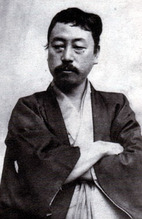 The Book of Tea Okakura Kakuzo [ excerpt ] (Intro by Liza Dalby) - When first written, “The Book of Tea” was only really meant for a small group of people - but it’s popular has grown over time (especially in the “West”).
- Meant for “narrow elite, who might be expected to join in his protest against the spiritual misunderstandings that separated the East and West.”
- Trying to change tea from “cult of Japan” into something more meaningful (art, harmonious with daily life, natural...)
The Cup of Humanity: - Teaism: religious aestheticism of tea (cult focussing on beauty in life), not materialistic
- Philosophy of Tea: beyond aestheticism, deals with ethics, religion, view on man and nature.
- Art, such as Teaism has not been appreciated as it should (it seems to trivial in the eyes of many who do not see simple/subtle things in life)
- The West has many ideas of the “East” due to the lack of effort in understanding. However the East also has an image of the “West” (“most impractical people on the earth”)
- Though some barriers between were attempted to be overridden it did not necessarily work. Mostly materialistic interaction...(fashion, consumer goods)
- For the purpose of better understanding, Kakuzo is saying this bluntly: “Unfortunately the Western attitude is unfavorable to the understanding of East...”
- “no tea” in the constitution of the “west” (despite the fact that there is definite tea culture)
- While tea was spreading over the world, it was met with opposition (some said “filthy custom”, loss of “comeliness” and beauty).
- West and Eat can meet in the recognition of the Imperfect.
The Tea Room - Sukiya - humble (made of bamboo and wood, straw hut)
- apparently barren due to its simplicity
- tea room, portico, garden path (steps toward enlightenment)
- good tea room should cost more than a mansion (workers, materials etc)
- a tea room can displace you (from city to forest - arousal of the senses)
- the small door into the tea room is to level hierarchy of people (through humiliation)
- if there is dust- you are not a tea master
- the tea room is made FOR the tea master (not the other way around)
- However with zen and buddhist ideals, the tea room/house became only a temporary refuge for the body (rather than a deeper connection)
- inspired by the zen monastery tea room (bare except for alcove) - simplicity!
- There should only be one changing aspect (focus/appreciation) vs. WEST many, stationary
- Tea culture has been finely crafted - all aspects thought out
- Taoist/Zen ideals of perfection is more about the process (therefore guests are left to imagination to complete the effect of the space “in relation to himself”)
- In Western homes things are ruled by symmetry and repetition (why do we have a portraits, food pictures, flower pictures in a room with all of those items in it already?)
Definitely interesting ideas - I had never thought about why we (in the WEST) have decorations that reflect the purpose of the room - how it is weird to have these mirrored thoughts. I wonder about the details of the tea - but that is something I can never tred upon...
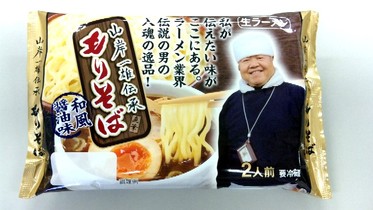 Japanese Foodways, Past and PresentChapter 13: Ramen Connoisseurs Class Gender and, the Internet
Satomi Fukutomi
Ramen As A Japanese “National Dish” Ramen from cheap/fast to a mastered art: - customers waiting up to 12 hours outside ramen shop of Yamagishi on his last day
- “national food” (consumed my nation)
Ideas of class: - taste is cultural, political, economical product (authenticity is reinvented through prestige)
- prestige is tied to class, but class cannot be definitely defined
- connoisseurship is tied to class and therefore popular culture
Ramen has become a national dish due to its general popularity (it is widespread) as well as its regionalization. It can be considered “local speciality food” in almost all regions. There are even a ramen museums and theme parks! It seems that ramen critics/consultants help keep the ramen “industry” moving - promoting over a variety of media. The internet, though, has been vital in this boom of ramen where both dry info and emotion are brought to attention. Crossing Class Boundaries and Ritualizing Ramen:- In the past ramen was food for “blue-collars” and “rough masculinity”.
- Development of the culture of eating out (aesthetic, white collar starters, incorporation of fashion industry) have helped transform that image (1996 “Ramen Revolution” says Osaki). Rituals also imbedded in the atmosphere (clothing, shouts, decor, attracted customers).
- White collar men are targeted more because they are often on the go and wealthy enough to pay the 800 yen price.
- uri - selling point (this came in the style of the restaurant, whether it was “Japanese”, “Western” or “native/foreign hybrids”.)
- With “authentic Japanese” styles, the name of shop also makes a difference and often the shop ends of sending the message of “old Japan”.
- Women are also more targeted (appealing interior) and paying close attention to ettiquette (providing paper aprons).
- Part of the movie Tampopo where the man explains how to eat ramen correctly is an example of raising the level/expectation of the food itself - this exaggerates the ramen culture while noting some truths including slurping ramen and drinking up the soup from the bowl.
“Eating Loud” and Gender in Ramen- Though dining out is considered classy, eating noodles loudly is a part of culture that can be dismissed despite the other baggage that goes along with eating out and high class life (etiquette, “what, where, and how to eat”).
- Ramen is loud and fast food (speedy prep, speedy eat, speedy next)
- Though now a lot of older ramen shops are targeted at men, shop owners are feeling the need to spread to women as well (feeling that they have a huge impact on market).
- Also the culture around men and women’s eating habits are very different.
Gendered Space in Virtual Consumption:- Virtual Consumption (on the internet) is very popular with women because it includes talking ABOUT ramen.
- “Internet serves to establish community and popular culture and create identity” (267)
- (this can include cyber ramen nerds as well as ramen aficionados)
- However this alienates the older generation and blue collar consumers who are not as savvy with the internet.
- Women, though, are sensitive to image/identity (it is not exactly fashionable for women to go into old fashioned “men’s” ramen shops, but can be looked upon as “brave”).
- Gender boundaries are not removed
Below or some questions we were asked to consider while viewing the movie タンポポ (Tampopo) which means "Dandelion" in English. - What culinary rules or conventions are represented? (Are they ever subverted or expressly enforced?)
- How does the film represent the relationship between culinary conventions and social conventions (i.e., in terms of class, gender, age, occupation, etc.)?
- How does the film copy or parody other genres of film?
- What characters (or character types) have culinary authority?
- How does the concept of “authenticity” come up in the film?
- What about the film is Japanese? Could it be re-made in a different national or ethnic context? (How?)
Though there is one story (the story of Tampopo transforming her dull ramen shop into a place of culinary art) there are other vignettes that find a happy place in the movie. - The rich couple that find sexual inspiration/satisfaction in food.Their love of food is equivalent with their love for one another. It is the medium through which they display their affection and love. I don't think we ever see them actually eat anything (at least together)- it is this beauty that is always around them - an accessory of their passion. We see the man eat an oyster fresh from the ocean after he cuts his lip on the shell. The girl who collected it kisses him after licking the blood from his face. I'm not sure what to make of it, except for perhaps that both are forms of nourishment/healing. The providing and consuming act, the healing and affection...But the couple have several moments.
- at the theater - served a table of very classy still life-esque foods while expressing distast for "loud" foods such as potato chips
- scene with lots of food (happy!)
- egg scene
- fresh oyster
- man's death (eating wild boar intestines hunted in winter due to yam diet, sweet intestines grilled over fire - last words are talking about this, about how they will eat this together one day)
2. Tampopo's story that is very intertwined with characters: Goro (truck driver who keeps faith in Tampopo and helps to train her into a ramen master), Gun who is Goro's work partner and acts often as comic relief, Pizken who is presented as a rude man sweet on Tampopo but comes around and becomes their team's interior designer, the Sensei who helps Tampopo master her soup making skills (who is a highly respected homeless man from a food loving homeless community) and, Shimei, a chef that was asked to help Tampopo after she saved his boss from choking on mochi. Tampopo also has a son who thinks his mother is tough due to her skills as a "good cook". This team of characters leads us through the adventure of training Tampopo to become a master of ramen (literally with running drills, lifting pots of water, timed ramen preparation drills and, quests to other shops to observe routines that are positive and negative). The vibe we get is very similar to those of a Western movie (and it is actually considered a spoof on Spaghetti Westerns, rather a "Ramen Western" tee hee!).
3. Other snippets are shorter and less visited. This includes a group of business men who go to eat a fancy French lunch. There is one younger assistant who seems to be very clumsy. The menu is in French and after an awkward silence one man orders. All the other men proceed to order the same thing (disguising the fact that they have no knowledge of the French language or the cuisine). Finally, it is the assistants turn to order and we are surprised to see that he knows items on the menu and even the origins and the matching of flavors. At first his boss kicks him under the table because since he is younger, it is out of place to openly display this knowledge beyond his superiors. However he ignores it, set on getting the best meal! The waiter is impressed - and so are the others.
This is an example of moving past social convention. Especially in Japan where respect for those "above" you is so crucial, this young man completely disregards it for the sake of food. 4. When Tampopo, her son and Goro go to find Sensei in the homeless community, the other homeless men talking about their great finds in foods and creations. One asks what the son would like and he saus Omuraisu, so they sneak into a kitchen and the man created a very beautiful, scrumptious looking omuraisu dish for the boy. It is a really cute sequence, though they narrowly miss the policeman prowling the building.
Here food enjoyment and love breaks through class, even the homeless find good food - making the best with what they have - and still carefully molding their tastes. We are forced as viewers to admire this passion (even when they have so little, they can make so much of it! Wow!)
5. Another moment is when a man is on a train with some awful pain in his mouth. He is served dim sum, but obviously can't enjoy it so he goes to get the trouble checked out. They proceed to surgery and remove something/pop something (I'm not exactly sure) that was in his mouth causing him all this pain. They advise him to eat soft foods so he gets soft ice cream and sits on a bench. He sees a little boy staring at him with a string around his with a message and a chunk of carrot strung onto it saying "Please don't feed me sweets, I only eat natural foods". After thinking and looking at each other, the man gives the child the ice cream - the child starts at it and enjoys it.
This is an example of sharing - the act of giving - and especially food sharing is really key in relationships. This is considered a very strong action, providing nourishment - because there is a lot of trust involved as well. It is a very sweet scene.
Really quickly a couple more include:
6. The etiquette class on how to eat "Western" style with a spoon and fork. A foreigner in the same restaurant as the class starts slurping up his pasta. The students observe and copy him rather than the teacher (though her original instructions were to not make a sound, the audio becomes a rage of slurps). I think this is breaking rules of etiquette - a mashing of cultures. This is almost very amusing because of the contrast between Japanese and "Western" noodle eating styles.
7. An old woman goes to the super market late at night. We see her with the peaches, and she kneads with her thumbs to a point that makes the view uncomfortable. The flesh is dented and juice spills out. At this point the shop keeper sees what's happening and she moves on to cheese. This sequence is very odd, the old woman and the shop keeper chasing (an abstract gun/action scene of hiding and attacking in an adventure/Western film perhaps but with Pink Panther-esque music). In the end, breads, cheeses and fruits have suffered in her hands but the shop keeper wins, slapping at her hands with a fly swatter. Perhaps we are supposed to never suspect an innocent older woman (who is stereo typically a sweet little grandmother who cooks passionately and provides delicious and beautiful meals of tradition) to be the culprit in such destruction and strangeness.
8. Oops! I forgot one of the beginning scenes where Gun is reading a book about ramen eating. It is visualized for us, and we watch Gun being lead through the very intricate process of how to eat ramen like a master (who has been practicing it for 40 years).
9. For the ending credits, it is a woman breast feeding on a park bench. I feel that this scene finalizes the message - the forms food relationships and food meaning can have in people's lives. Mostly, the pure love of it and the love that is displayed through food.
| This movie has too many "Japanese" cultural references to really have the same effect while keeping the story if made in a different culture. Of course, that is my opinion. Things like respecting elders/superiors, the Japanese obsession with refining skills and considering most aspects of life an 'art', gender roles (references to being lady-like, tough paralleling cooking skills etc...). Also I think the other reason that makes this movie hilarious is how Juzo Itami (the director) uses themes/music/cinematic styles of Western movies/adventure movie and what not. It is taking the idea of the hero doing great deeds and setting on a woman making great ramen. Tanpopo waits nervously, seeing if she passes the test - waiting to see if they set the bowl to their lips and drink every last drop of broth!
With Tanpopo's success in herself, her shop also succeeds and her son overcomes his bullies and they become friends. Mostly happy ending! |
 Grodinsky “The Joy of Soy” chapter 3 from A Taste of Health Miso and soy sauce, both soy products, are used in one way or another in just about every dish in Japanese cuisine. Soy Sauce:- first known reference to “soy sauce” is from 1597 in the Ekirinbon Setsuyoshu as “tamari shoyu”
- soy sauce came later due to the machinery needed to create it (squeezing liquid from the beans)
- not easily done at home like miso
- Noda is where commercial production became and it still remains prominent
- 50 yrs or so passed and they had arranged the flavor with half roasted wheat and half soy beans and created their pure product of “shoyu”
consumption: - In the 18th century 14.5 liters per year per person of soy sauce were being consumed.
- Nowadays it’s down to about 9 liters per year per person.
Popularity: - 17th century, Japan began exporting soy sauce (now it exports to 100 countries)
- Soy sauce grew in popularity during WWII because of American Soldiers returning home after time in Japan
- 1957, in the USA soy sauce sales were growing at about 15% a year
- 1973, Kikkoman opened factory in Wisconsin (otherwise soybeans woudl always be exported to Japan, then imported BACK in as soy sauce - a waste of everything!)
MISO:- “In many ways, miso is to Japanese cooking what butter is to French cooking and olive oil to the Italian way.” - Shizuo Tsuji, Japanese Cooking: A Simple Art
- 8th century there was miso but it wasn’t shared by everyone until about 12 century (mostly likely due to Buddhism encouraging simple diets) which helped define a “simple” meal of rice, miso soup and pickles.
- There is a huge variety of miso (similar to that of the variety of cheese in France).
- Also a huge variety of HOW it is made (some made with rice, barley, dark, light, sweet, salty etc...)
- Until about 1960s miso was made at home.
Consumption: - A Japanese eats a few tablespoons of miso per day (according to stats)
- It can be used in soup, as a marinade, sauce, pickling, dishes like dengaku, nabe...
Fermented Soybean Products and Japanese Standard Taste by Erino OzekiStandard Taste As a Cultural Model- we recognize a repeated flavor/taste eventually as a cuisine
- instances where people return to their childhood flavors include: shocked by exotic flavor/living for a long period of time in foreign place
- our original childhood flavor preference is what we judge all other flavors by
- Standard taste is often misunderstood and takes the form of a stereo typed food item in a culture
- this this usually the product of ingredients/seasonings etc... simply being uncommon
- In history availability of foods and “suitable processing and cooking methods” guided taste
- in ca be influenced by introduction of foreign products (such as red hot pepper in Korea)
- discovery of using ingredients differently etc... (soy over fish in modern Japan)
- “Standard tastes are deeply associated with particular ingredients and specialized preparation techniques”
Standard Taste: The Japanese Case- Two Major Elements: dashi and fermented soy bean products
- these tow could have been pivotal due to “Umami cultural area”
Origins of the Components
Dashi components:1.) kombu - first mentioned in Shokunihongi AD 797
- first used for dashi in Genroku Period (1688-1704)
2.) katsuo bushi with mold appeared in Edo Period (1603 - 1868) - Dried fish (particularly katsuo-bushi)
- eaten as early first century BC (Yayoi Era)
- eighth century AD (Nara Era) references to it as dried fish and boiling it became common
- the name didn’t appear till Muromachi Period (1333 - 1573)
Hishio - salt fermented food such as grains, fish, meat, or vegetables. - 1.) salted soy and grain varieties 2.) salted fish and meats 3.) pickled vegetables
Misoshiro - Muromachi Era, when mortar and pestles became more popular - By the end of the Edo Period skills and procedure had improved miso
The Persistent Nature of the Standard Taste- About a thousand years passed between the introduction of jiang/miso and katsuobushi and it as a standard taste
- It was early 19th century when miso, shoyu, kombu, katsubushi became affordable
- then it developed as a steady and “persistent” standard taste
The strength of the Standard Taste (people are returning to it, even though so many exotic/foreign options are available). - Slow food movement has been spurred by mass media showing homecooking as “traditional” and “authentic” - anti-fast food movements
- However fast food still is moving along, through other ways such as convenience stores
- now customers want high quality and fast at the same time
- Both Fast food and Slow food are moving towards more traditional ways
Ongoing and Prospective Changes- Changes that have occurred:
- ready made instant dashi (loss of patience for slow home cooked dashi)
- miso/shoyu/fermented soy products have become lighter in flavor (no longer needed for preservation and health awareness)
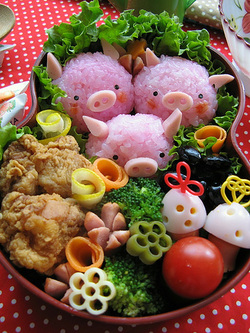 Japanese Mothers and Obentos Anne Allison Obentos - packed lunches for children
- decorative, nutritious
- help define a good mother
- outlet of pleasure and creativity for both mother and child
“Both the child and the mother are being watched, judged and, constructed; and it is only though their joint effort that the goal can be accomplished.” Two structures of Power: - Repressive State Apparatus (SA) - power through force
- Ideological State Apparatus (ISA) - intention other than political power (health or media etc...) accepted and practiced and therefore enforced
Obentos can be a cause of stress in mother and child. Why perhaps? 1.) there is a standard for obento making 2.) the preparer has the responsibility to meet those standards Education: - Example of social order and gender roles in Japan
- Education is what initiates ideological state apparatus in Japan (beginning in nursery school)
- knowledge and ideology become one
- education defines a student as they become adults in society
- divide between soto and uchi - traumatic to attend nursey school (eased in with obento)
- also obento is a model for the child (good mother, therefore good child)
- child’s success is sometimes judged more one routine (social order is taught in nursery school)
- obento is “instutionalized” because of schools, enforcing housewife role
Obento Standards: - variety, beauty, healthy, easy to eat, “disguising food”/food transformation, capturing/containing nature
- it is hard work because you are a committed good mother willing to do that/only way of expression
Gender: Men are restricted to working outside of the home Women are restricted to the labors of the house (or low paying jobs) “Motherhood is state ideology, working through children at home and at school as obento.” Example of "breaking free": As a product of being raised on simple bentos (one that was not caught up in the ideology) Sawa has been able to break free and become independent.
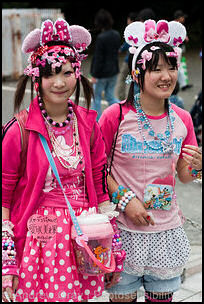 rising sense of "individualism" Made Better in Japan by Tom Downey “For decades, Japan simply imported the wares of foreign cultures, but recessions has led to invention. The country has begun creating the finest American denim, French cuisine and Italian espresso in the world. Now is the time to visit.”Japanese people tend to be perfectionists in some areas such as cuisine Imported goods become “Japanese” (bread, pasta...) During the 80s Japan had chefs come from the world - creating “haute bourgeoisie heaven” Now Japan is creating for themselves, decreasing imports In cooking new goal is not a “cuisine” but “how to make the whole dining experience better” Tokyo has 247 stars in “the Red Guide” for restaurants (more than a lot of other famous cities) - previously mostly kaiseki and sushi
- now more other cuisines as well
Tiny restaurants, personal interaction = “firmly rooted in Japanese tradition” Japanese chefs are “the most highly trained and technically adept in the word” Other chefs think quantity/expand while Japanese chefs think connections/quality Hotels are usually more international but others with majority Japanese guests adopt “native customs” (perfectionist hospitality) “devotion to craft” RE-MADE in JAPAN Introduction by Joseph J. Tobin “Everyday life and consumer taste in changing society” Domestication Though Japanese are very productive, they are also very consumeristic (particularly in Western things) Japanese are not just Masters of imitation/adaptation, they are engaged and creative, inventing - DOMESTICATION (not westernization, imitation, etc...)
- domestication is a more active role
- imply Japanized (because westerner’s are not necessarily familiar with the “westernized” Japan, this idea is apparent in Language as well)
Puzzling issue: “How could Japan have become the preeminent postindustrial society without going through the stages of preindustrial development in an orderly way?” Now Japan is “prototypical late-capitalist, post-modern, mass culture, information-based consumer society”, “First truly postmodern land” “...Japanese domesticate the West by consuming Iowa beef and Maine lobsters at a French Restaurant in Hawaii, by bring home high-status souvenirs from trips abroad, by incorporating romantic English lyrics into their popular songs, and by spending a day in the Old West of Tokyo Disneyland.” (9) Gender roles: where in the past men were considered the producers and women the consumers now it is balanced where both consume and produce. - Also in the past the West was masculine (colonial) while the East was feminine (symbolized in Madam Butterfly)
(odd fact...) “Christmas Cake” - a woman over 25 “losing appeal” like a cake on december 25th. How the West has made it into Japan:- foreigners in Japan
- during the Occupation
- American TV and movies/music (later on with the Nostalgia Boom)
- now it is Japanese advertising industry
- through cities
Rural vs. Urban Tokyo = Japan’s West and the countryside = Japan’s Japan - despite the shift of generations into the city, they still carry with them values of the country and sometimes even dream to return
Middle class and consumerism There are many different levels of middle class within the “middle class” of Japan - nyu ritchi (nouveau rich)
- danchi (apartments)
- kikkai binbo (machine poor)
- nyu binbo (new poor)
The classes are defined by taste and though for a long time better taste meant more western, it seems to be returning to the roots (but in a modern sense). Carnivalesque: Japanese culture does not attach guilt to high consumerism (they spend a lot and for numerous reasons including repayment, power, “investments in future favors” etc...) Individuality in JapanContact with the West = “awakening of individuality”= “spiritual breakdown of the soul” = “the modernization of the soul” - privatization of urbanized intellectuals, their taste became more western
- now it has gone from individuality to alienated (obsessed with pleasure, elders call Shinjinrui”, the young are like another species)
“One purchases things in themselves but a lifestyle defined by things” Boundaries have changed as well: - no tatami mats in modern buildings (no clear distinction of inside and outside)
- boundary shifts on an individual level as well
- family level (the new lifestyle does not always include older generations or children)
- foreign or Japanese (though this boundary is constantly shifting)
Japanese people have adopted/domesticated even things like McDonalds so much that on trips one might go there for a taste of “home” Modern Japanese are torn between “modernity and nostalgia” Country bumpkins are proud to be a part of a “traditional” Japanese lifestyle - this pre-modern image of Japan has been fetishized
- besides agricultural income, farmers can also use their lifestyle/home as a tourist attraction for nostalgic city folk (authenticity is consumed!)
1.) Self-exoticization : making themselves as Western as possible (eyelid operations) - make up for the inferiority/self consciousness (introduced by contact with the west)
2.) Self - orientalizing : making oneself into an object of Western desire (Asian on Western terms) Before the West, Japan had been “borrowing” from China, Ainu and, Korea Japan-China relationship is complicated. China’s influence/relations with Japan are undeniable - constant struggle of identity and “authenticity”
Returning from Westernization - jikkan (“retrospection through actual sensation” - the senses trigger connection to “authentic” Japanese culture)
- however the younger generation cannot find the connection/sentimentality in this sensation (they are, rather, very materialistic and focussed on the new almost to a point where it is parodic, but is the joke on the west or on Japan?)
BESTOR Tsukiji Chapter 4 The Raw and the Cooked - Seafood is next in line after rice as a dependent in food culture of Japan
- things as simple as it’s colors/shapes/myths around prepping
- Tsukiji traders have come about as experts due to the changes of seafood in Japanese cuisine
- Seafood has so many details and attachments (quality, region, holidays, identity etc...)
- Tsukiji Market is a reflection of the broader view of distribution/consumption that happens in Japan
- Tsukiji Market is controlled by “social institutions and values of capitalism as a cultural system” (effects of cultural, social, political, technological, environmental influence)
- Two sides of commidification (economic and cultural)
- material circumstances/food are part of the flow in changing social, political, economic situations (they control production and consumption)
- cuisine is tsukiji’s product
In Media - mass media helps pull the development of cuisine along
- Japanese consider food origin/agriculture a topic of great interest
- as entertainment as well as the political and economic aspects
- Travel shows (cuisine shows with celebrities) exposing thin lines between
- different cuisines by geography
- culinary nationalism
Identity: - food symbolism have connections to cultural history of Japan
- therefore “defined by what they eat”
Authentic: - “raw seafoods” while that really is just normal food (natural)
- as “Japanese” has moved further, increase in imports
- govt has to blend imported/domestic rice
- food dependency, inferior items (kata)
- mass imports: questioning cleanliness in rawness
- Aquaculture is increasing because it is stable and more uniform
- Japanese agriculture/fisheries are tied to identity in order to protect economic importance
- Japan’s demand of seafood and “methods of catching it” are major
- environmental criticism (whales) is attacking Japan as a whole
- insecurity of dependence on other countries
- Technological advancements ( Industrialization) : “homogenized national fare has gradually replaced regional varied ones” that were only based on whatever was available in that region/and with certain preparation = “westernization”
- Freshness still trumps brand name though in other areas supers are taking over
Gourmet Boom: - “industrial food” is a part of class structure (shifting away from local)
- Edo-mae - nigiri sushi from seafood from Tokyo Bay (“authentic”)
- Shift to more seasonal, natural etc... “authentic”
Domesticity and Cuisine: - even “American” chains are so grounded in Japan, it has become a part of the “mass-market taste”
- many new appliances - drastic difference between now and 1950s
- family culture has shifted as well -
- which then shifts the food consumption practices of the “nuclear family”
- gender role change
- 7/11 and dept. offer osechi as well house cleaning
- this change separates people from Tsukiji where kata and other knowledge is so key
The impersonal touch: - relationship between home and food is changing
- more “car culture” (eating out)
- “eating out boom”
- kaitenzushi - tasteless, impersonal, easy (parallel to consumer spending habits)
- now they have better ones
- mom and pop shops are disappearing - only single category (fish/sake)
- conbinis- has become “local food store” for some
- generation/age - has a lot to do with where you will shop, probably depend on your values
Time to Eat - “time defines buyers’ tastes and preferences”
- weekends=better food, different hosting situations are a guide to where to eat
- seasons and rituals conduct food consumption (rokuyo, calendrical cycle for lucky/unlucky days)
- Advertising over actual cultural tradition is what has propelled the ritual food culture
Fish Fight Back - “ritual memorials” for lives taken for food (even fish)
- cruel cuisine” zankoku ryori (serving still living fish)
- “horyu” releasing animals back into the wild
- “kuyo” apologizing and thanks to fish (memorials appear)
Webs of Cuisine
Tsukiji traders: must be knowledgeable, sensitive to holidays/rituals as well as international food dependency situation
they think only of what the consumers think of the fish (the customer is always right)
“man is an animal suspended in weds of significance he himself ha spun” Clifford Geertz
|

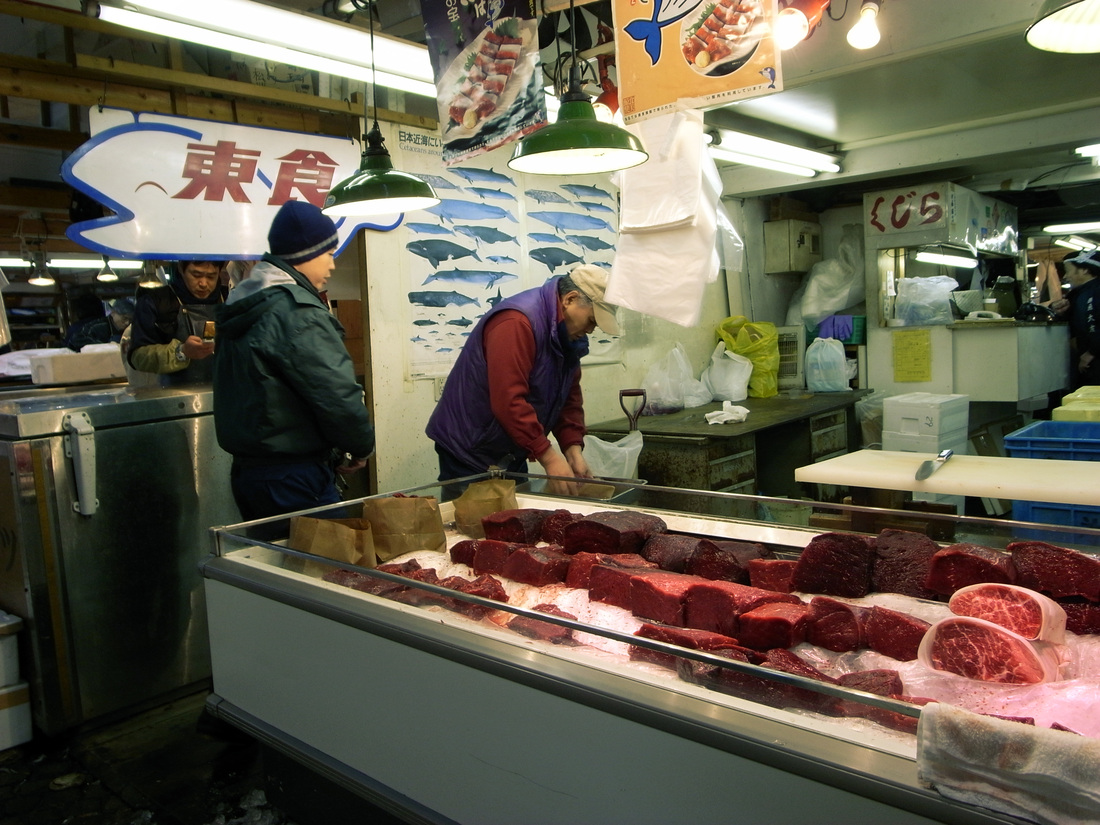

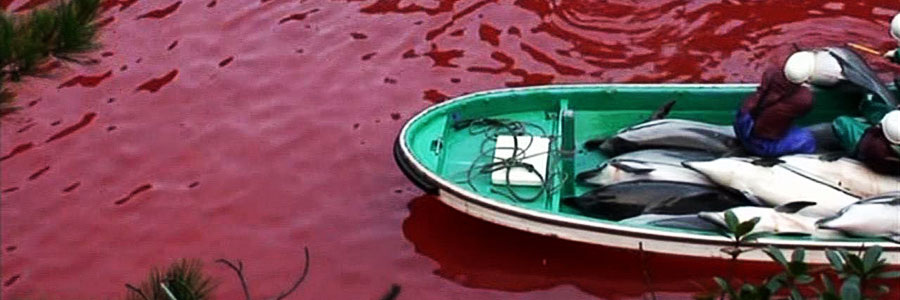

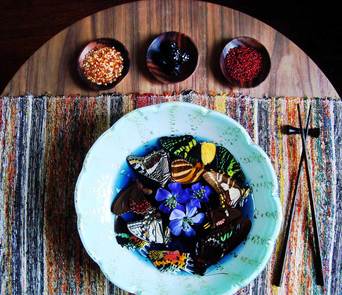


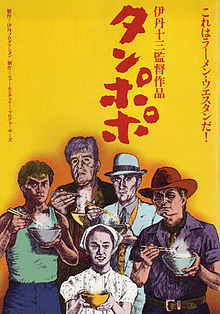
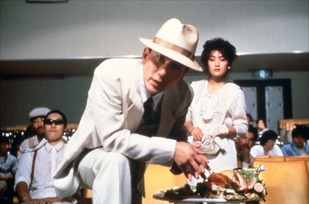
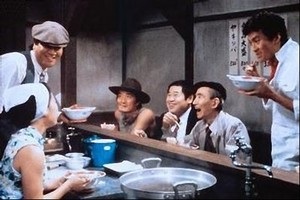
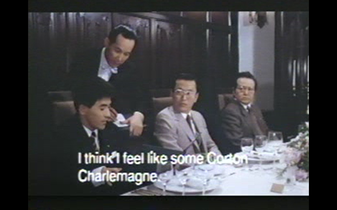
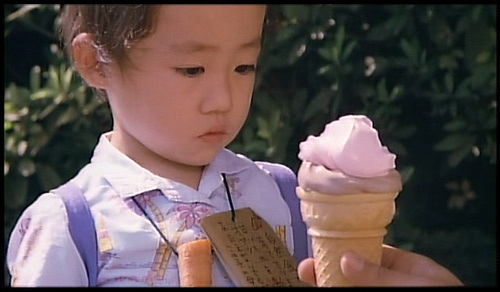
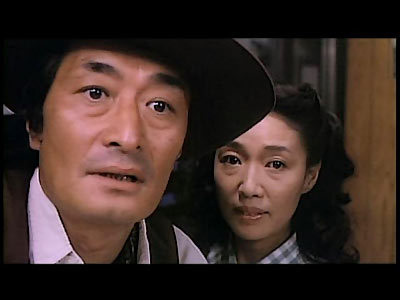
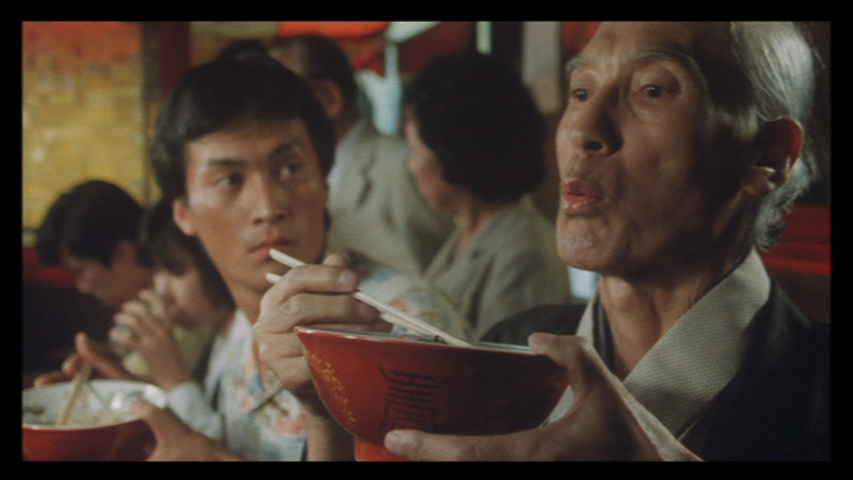
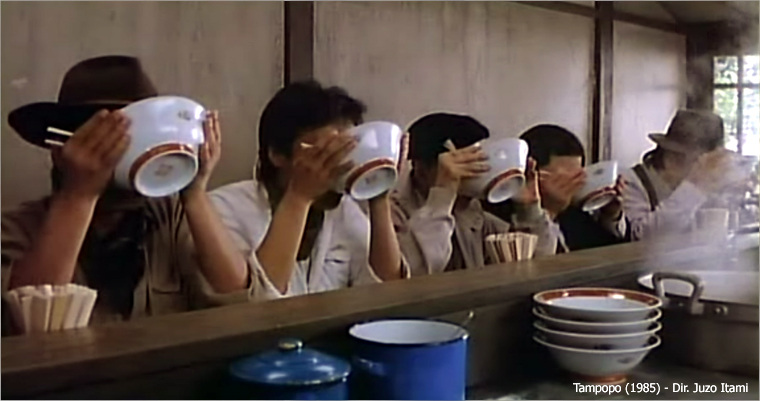



 RSS Feed
RSS Feed